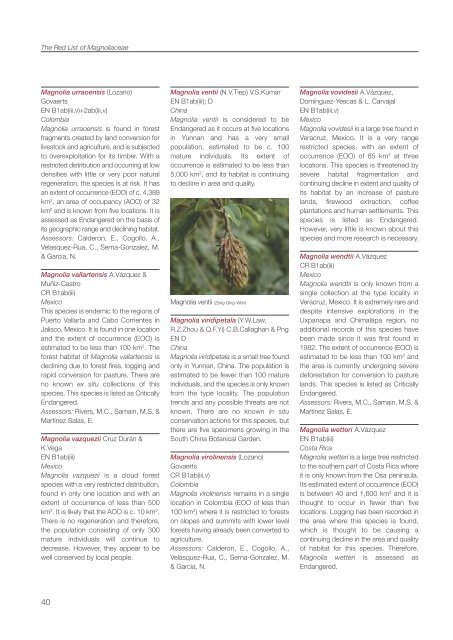Magnoliaceae
Magnoliaceae_RedList_2016_LowRes
Magnoliaceae_RedList_2016_LowRes
Create successful ePaper yourself
Turn your PDF publications into a flip-book with our unique Google optimized e-Paper software.
The Red List of <strong>Magnoliaceae</strong><br />
Magnolia urraoensis (Lozano)<br />
Govaerts<br />
En B1ab(iii,v)+2ab(iii,v)<br />
Colombia<br />
Magnolia urraoensis is found in forest<br />
fragments created by land conversion for<br />
livestock and agriculture, and is subjected<br />
to overexploitation for its timber. With a<br />
restricted distribution and occurring at low<br />
densities with little or very poor natural<br />
regeneration, the species is at risk. It has<br />
an extent of occurrence (EOO) of c. 4,389<br />
km 2 , an area of occupancy (AOO) of 32<br />
km 2 and is known from five locations. It is<br />
assessed as Endangered on the basis of<br />
its geographic range and declining habitat.<br />
Assessors: calderon, E., cogollo, A.,<br />
Velasquez-Rua, c., Serna-Gonzalez, M.<br />
& Garcia, n.<br />
Magnolia vallartensis A.Vázquez &<br />
Muñiz-castro<br />
cR B1ab(iii)<br />
Mexico<br />
This species is endemic to the regions of<br />
Puerto Vallarta and cabo corrientes in<br />
Jalisco, Mexico. It is found in one location<br />
and the extent of occurrence (EOO) is<br />
estimated to be less than 100 km 2 . The<br />
forest habitat of Magnolia vallartensis is<br />
declining due to forest fires, logging and<br />
rapid conversion for pasture. There are<br />
no known ex situ collections of this<br />
species. This species is listed as critically<br />
Endangered.<br />
Assessors: Rivers, M.c., Samain, M.S. &<br />
Martínez Salas, E.<br />
Magnolia vazquezii cruz Durán &<br />
k.Vega<br />
En B1ab(iii)<br />
Mexico<br />
Magnolia vazquezii is a cloud forest<br />
species with a very restricted distribution,<br />
found in only one location and with an<br />
extent of occurrence of less than 500<br />
km 2 . It is likely that the AOO is c. 10 km 2 .<br />
There is no regeneration and therefore,<br />
the population consisting of only 300<br />
mature individuals will continue to<br />
decrease. However, they appear to be<br />
well conserved by local people.<br />
Magnolia ventii (n.V.Tiep) V.S.kumar<br />
En B1ab(iii); D<br />
China<br />
Magnolia ventii is considered to be<br />
Endangered as it occurs at five locations<br />
in yunnan and has a very small<br />
population, estimated to be c. 100<br />
mature individuals. Its extent of<br />
occurrence is estimated to be less than<br />
5,000 km 2 , and its habitat is continuing<br />
to decline in area and quality.<br />
Magnolia ventii (Zeng Qing-Wen)<br />
Magnolia viridipetala (y.W.Law,<br />
R.Z.Zhou & Q.F.yi) c.B.callaghan & Png<br />
En D<br />
China<br />
Magnolia viridipetala is a small tree found<br />
only in yunnan, china. The population is<br />
estimated to be fewer than 100 mature<br />
individuals, and the species is only known<br />
from the type locality. The population<br />
trends and any possible threats are not<br />
known. There are no known in situ<br />
conservation actions for this species, but<br />
there are five specimens growing in the<br />
South china Botanical Garden.<br />
Magnolia virolinensis (Lozano)<br />
Govaerts<br />
cR B1ab(iii,v)<br />
Colombia<br />
Magnolia virolinensis remains in a single<br />
location in colombia (EOO of less than<br />
100 km 2 ) where it is restricted to forests<br />
on slopes and summits with lower level<br />
forests having already been converted to<br />
agriculture.<br />
Assessors: calderon, E., cogollo, A.,<br />
Velasquez-Rua, c., Serna-Gonzalez, M.<br />
& Garcia, n.<br />
Magnolia vovidesii A.Vázquez,<br />
Domínguez-yescas & L. carvajal<br />
En B1ab(iii,v)<br />
Mexico<br />
Magnolia vovidesii is a large tree found in<br />
Veracruz, Mexico. It is a very range<br />
restricted species, with an extent of<br />
occurrence (EOO) of 85 km 2 at three<br />
locations. This species is threatened by<br />
severe habitat fragmentation and<br />
continuing decline in extent and quality of<br />
its habitat by an increase of pasture<br />
lands, firewood extraction, coffee<br />
plantations and human settlements. This<br />
species is listed as Endangered.<br />
However, very little is known about this<br />
species and more research is necessary.<br />
Magnolia wendtii A.Vázquez<br />
cR B1ab(iii)<br />
Mexico<br />
Magnolia wendtii is only known from a<br />
single collection at the type locality in<br />
Veracruz, Mexico. It is extremely rare and<br />
despite intensive explorations in the<br />
Uxpanapa and chimalapa region, no<br />
additional records of this species have<br />
been made since it was first found in<br />
1982. The extent of occurrence (EOO) is<br />
estimated to be less than 100 km 2 and<br />
the area is currently undergoing severe<br />
deforestation for conversion to pasture<br />
lands. This species is listed as critically<br />
Endangered.<br />
Assessors: Rivers, M.c., Samain, M.S. &<br />
Martínez Salas, E.<br />
Magnolia wetteri A.Vázquez<br />
En B1ab(iii)<br />
Costa Rica<br />
Magnolia wetteri is a large tree restricted<br />
to the southern part of costa Rica where<br />
it is only known from the Osa peninsula.<br />
Its estimated extent of occurrence (EOO)<br />
is between 40 and 1,600 km 2 and it is<br />
thought to occur in fewer than five<br />
locations. Logging has been recorded in<br />
the area where this species is found,<br />
which is thought to be causing a<br />
continuing decline in the area and quality<br />
of habitat for this species. Therefore,<br />
Magnolia wetteri is assessed as<br />
Endangered.<br />
40


